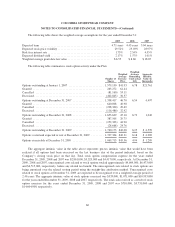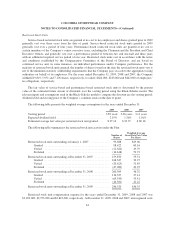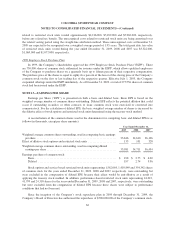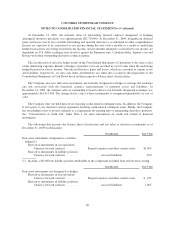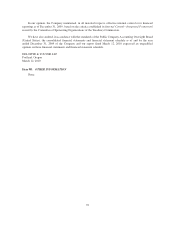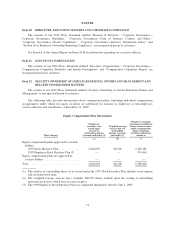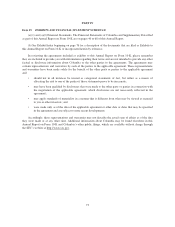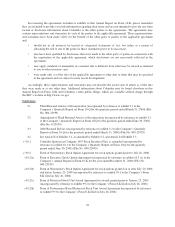Columbia Sportswear 2009 Annual Report Download - page 74
Download and view the complete annual report
Please find page 74 of the 2009 Columbia Sportswear annual report below. You can navigate through the pages in the report by either clicking on the pages listed below, or by using the keyword search tool below to find specific information within the annual report.
COLUMBIA SPORTSWEAR COMPANY
NOTES TO CONSOLIDATED FINANCIAL STATEMENTS—(Continued)
The following table presents the effect and classification of derivative instruments for the year ended
December 31, 2009 (in thousands):
Statement Of
Operations
Classification
Gain
(loss)
Currency Forward Contracts:
Derivative instruments designated as cash flow hedges:
Loss recognized in other comprehensive income, net of tax ............... — $(3,024)
Loss reclassified from accumulated other comprehensive income to income
for the effective portion, net of tax ................................. Cost of sales (740)
Loss recognized in income for amount excluded from effectiveness testing
and for the ineffective portion(1) .................................. Cost of sales (14)
Derivative instruments not designated as cash flow hedges:
Loss recognized in income ......................................... Cost of sales (130)
(1) During the periods presented, the Company recognized an immaterial amount of ineffectiveness.
NOTE 17—FAIR VALUE MEASURES
Certain assets and liabilities are reported at fair value on either a recurring or nonrecurring basis. Fair value
is defined as an exit price, representing the amount that would be received to sell an asset or paid to transfer a
liability in an orderly transaction between market participants, under a three-tier fair value hierarchy which
prioritizes the inputs used in measuring fair value as follows:
Level 1 – observable inputs such as quoted prices in active markets;
Level 2 – inputs, other than the quoted market prices in active markets, which are observable, either
directly or indirectly; and
Level 3 – unobservable inputs for which there is little or no market data available, which require the
reporting entity to develop its own assumptions.
Assets and liabilities measured at fair value on a recurring basis as of December 31, 2009 are as follows (in
thousands):
Total Level 1 (1) Level 2 (2) Level 3
Assets:
Cash and cash equivalents ............................... $386,664 $386,664 $ — $—
Short-term investments ................................. 22,759 22,759 — —
Long-term investments ................................. 826 826 — —
Derivative financial instruments .......................... 1,552 — 1,552 —
Liabilities:
Derivative financial instruments .......................... 1,955 — 1,955 —
(1) Level 1 assets include cash equivalents consisting of money market funds, ultra-short bond funds, bank
deposits and time deposits for which cost approximates fair value and long-term investments consisting of
equity-concentrated mutual funds held to offset deferred compensation arrangements.
(2) Level 2 assets and liabilities include derivative financial instruments which are valued based on significant
observable inputs. See Note 14 and Note 16 for further discussion.
There were no assets and liabilities measured at fair value on a nonrecurring basis.
67





